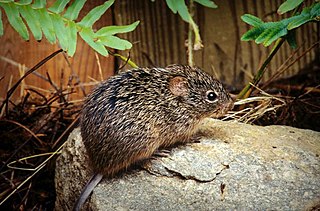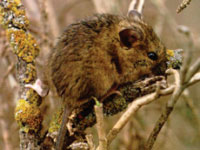
The rodent subfamily Sigmodontinae includes New World rats and mice, with at least 376 species. Many authorities include the Neotominae and Tylomyinae as part of a larger definition of Sigmodontinae. When those genera are included, the species count numbers at least 508. Their distribution includes much of the New World, but the genera are predominantly South American, such as brucies. They invaded South America from Central America as part of the Great American Interchange near the end of the Miocene, about 5 million years ago. Sigmodontines proceeded to diversify explosively in the formerly isolated continent. They inhabit many of the same ecological niches that the Murinae occupy in the Old World.

The Chacoan pygmy opossum is a recently described genus and species of didelphimorph marsupial. The only species in Chacodelphys, C. formosa, was known until 2004 from only one specimen collected in 1920 in the Chaco of Formosa Province, Argentina. The species is gaining popularity as a pocket pet.

Necromys is a genus of South American sigmodontine rodents allied to Akodon. This genus has also been known as Cabreramys or more recently Bolomys, and the northern grass mouse has recently been transferred from Akodon.

Apodemus is a genus of Muridae. The name is unrelated to that of the Mus genus, instead being derived from the Greek ἀπό-δημος.

The genus Eligmodontia consists of five or six species of South American sigmodontine mice restricted to Bolivia, Chile, and Argentina. Species of Eligmodontia occur along the eastern side of the Andes Mountains, in Patagonia, and in the Chaco thorn forest of South America. They can be found in arid and semiarid habitats and in both high and low elevation areas. These rodents are commonly known as gerbil mice or by their local name lauchas. Sometimes they are also called silky desert mice, highland desert mice or silky-footed mice. The closest living relatives are probably the chaco mice (Andalgalomys), the leaf-eared mice, and Salinomys.
Oligoryzomys chacoensis, also known as the Chacoan colilargo or Chacoan pygmy rice rat, is a rodent species from South America. It is found in the Gran Chaco region of southeastern Bolivia, southwestern Brazil, Paraguay, and northeastern Argentina. Its karyotype has 2n = 58 and FNa = 74.
Oligoryzomys microtis, also known as the small-eared colilargo or small-eared pygmy rice rat, is a species of rodent in the genus Oligoryzomys of family Cricetidae. It is found in western Brazil, eastern Peru, Bolivia, and northern Paraguay.

The gray leaf-eared mouse is a rodent species from South America. It is found in Argentina, Bolivia, Brazil and Paraguay; its habitat includes the Gran Chaco.

Reithrodontomys is the genus of groove-toothed New World harvest mice.
The Chaco grass mouse is a species of rodent in the family Cricetidae. It is found in Argentina, Bolivia, and Paraguay.
Olrog's chaco mouse is a species of South American rodent in the family Cricetidae, endemic to Argentina. The natural habitat of the species is hot deserts. Its karyotype has 2n = 60. The species is named after Swedish-Argentine biologist Claes C. Olrog.
Pearson's chaco mouse is a species of rodent in the family Cricetidae. This mouse is found in the Gran Chaco ecoregion of southeastern Bolivia and western Paraguay at elevations up to 400 m. The species is named after American zoologist Oliver Payne Pearson. Its karyotype has 2n = 76 and 78 in the two subspecies. The latter is the highest diploid number of any species in the tribe Phyllotini.
Habromys is a genus of rodent in the family Cricetidae, found in Mexico and Central America. It contains these species, all but one of which are threatened or endangered, five of them critically so. H. lophurus is near threatened.

Holochilus chacarius, also known as the Chacoan marsh rat or Chaco marsh rat, is a semiaquatic species of rodent in the family Cricetidae. It is found in Argentina and Paraguay within the Gran Chaco.

The Didelphinae are a subfamily of opossums consisting of 15 genera and 123 species. Specimens have been collected throughout the Americas, but are predominant in South and Central America.
Roig's pericote or Roig's chaco mouse is a species of rodent in the family Cricetidae. Its karyotype has 2n = 60 and FN = 120. It may be a subspecies of Olrog's chaco mouse.
The Paraguayan bolo mouse or Paraguayan akodont is a species of rodent in the family Cricetidae. According to the IUCN, it is present in Bolivia, Paraguay, and Peru, and possibly also in Argentina and Brazil. It is found at elevations from 300 to 2,030 m in a variety of habitats, including cerrado, chaco, and heath pampas.
The delicate salt flat mouse is a sigmodontine rodent species in the family Cricetidae from South America. It is the only species in the genus Salinomys. Its habitat is scrublands bordering salt flats in the Monte Desert area of central western Argentina at elevations around 400 m. The closest relatives of the species are the chaco mice (Andalgalomys).
Bibimys chacoensis is a species of small rodent of the family Cricetidae living in the north-central part of Southern Cone of South America. The common name of this species is Chaco crimson-nosed rat. It is one of the three species currently recognized under the genus Bibimys.








